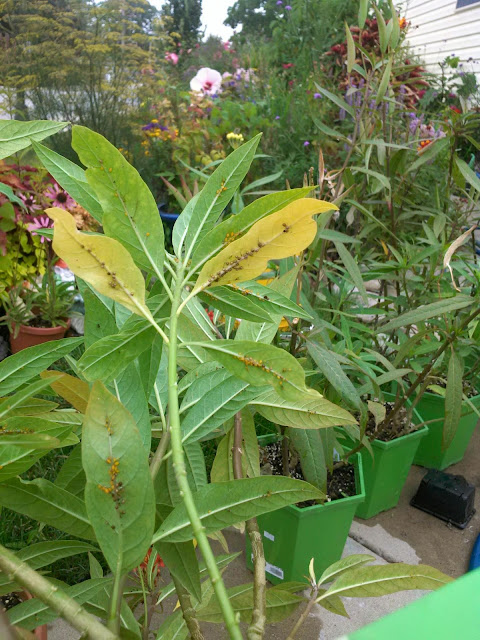The season started slow with only finding a few eggs to collecting 30-60 daily at work and home. I have to thank my seasonal works who are getting into the conservation thing and actively looking for eggs for me. We have milkweed at almost every park and facility where I work and so that makes collecting easy. I did this by design but also from an educational standpoint. Our facilities (park district) have kids and moms and dads going in and out all day, not to mention day camps! I want those kids visiting to say, I saw a monarch butterfly lay her eggs today at camp! We have a wonderful Naturalist that works with us and she does the bulk of the education. So anywhere I can help that out, make it more convenient.... I grow all the mw we use in the parks in our greenhouse so it is all pesticide free.
Oh and the nice garden club lady who dropped off a caterpillar, thank you. It will be well cared for by little Gwennie.
At home where I raise these eggs into butterflies, is a little chaotic right now. We are in the tail end of a renovation project and I have no tables in the house. I can't wait to get my dining room up! I need a project space. The hatching boxes where the eggs go are literally on the kitchen floor.
When I bring eggs home, I "process" them. By this I mean that I get a clean hatching box. I clean with bleach and make sure to rinse and dry well. I then place a paper towel in the bottom of the box and spray it with a little spray bottle. Make the paper towel a little damp. The reason for this is too keep the eggs alive until the eggs hatch. After I get them all into the boxes, I count them, make sure any funny looking ones get closer inspection with a jeweler's loupe.
http://www.amazon.com/dp/B00533VJSG/ref=wl_it_dp_o_pd_nS_ttl?_encoding=UTF8&colid=GRI0HJNXLA91&coliid=I143UQMWVJG2EK
Any bad eggs go out. I make sure there are no aphids or anything nasty on the leaves. Then I seal the box. This is important. Seal the box, make a hydration chamber so leaves live. I also open and close those boxes at least once a day to get fresh air in. You will want to see if they are hatching anyway. And then you wait. When they start hatching, after 2-4 days, I start putting new food in. Wash the leaves off and pat dry. I don't always transfer every tiny cat. to a new leaf. That would be too time consuming for the numbers I am taking care of. However when I had less than 100 I would definitely transfer them. I use the tip of a toothpick. Some use a paint brush.
Feed the cats and clean the boxes daily. Period. If you do not want a bacterial outbreak and cats dying, cleanliness is the most important aspect of this activity.
For my operation, when the cats get about an inch or so in length I think about taking them out to the caterpillar house. This is a structure built by my husband, Lee. It took him about 20 hours to build and believe it not, he used no plans. We deconstructed the old cat. house and there was enough wood there to reuse into the new one. He only had to buy a little bit of wood.
While out in the cat. house the cats are fed from large cuttings of common and tropical mw. They are in vases that are weighed down with marbles and the opening of the vase is covered with plastic wrap to keep cats. from falling in and drowning.
Then they just do their thing. Eat until it is time them make their chrysalids. They wander around the cat. house for a while and settle in a spot. When they eclose, I release them the same day.
So why do I do this, all of this? I definitely have enough to do over the summer. I work full time, lecture at garden clubs, but only a few in the summer. I have a large garden to take care of and other responsibilities.
I don't want to get all sanctimonious about this and say that I am going to save this species. I have genuine sympathy for the monarch and their plight. I do this because the symbolism of the metamorphosis is important for me. I think that this species is a good ambassador for all the insect world and why we should protect them. Except aphids. I don't like aphids. Oh and mosquitoes...oh well. Most insects are really cool and beautiful. And I do it because it is fun. Although this week it is feeling like a job. :)
Next up I will address those insects that also use mw for their home.
 |
| The hatching boxes, only 20-25 in each |
 |
| Out in the Garden |
 |
| The "Nursery" |
 |
 |
| The large Monarch Waystation at work, cared for by devoted volunteers! |
 |
| The first batch of cats. in the house |
 |
| The first batch in the house |









